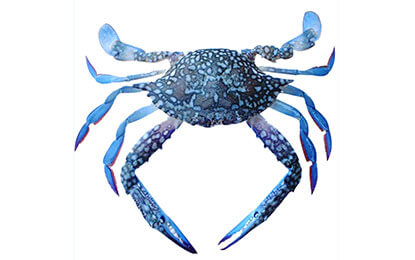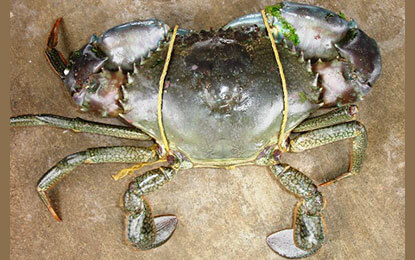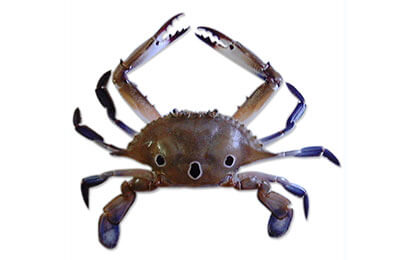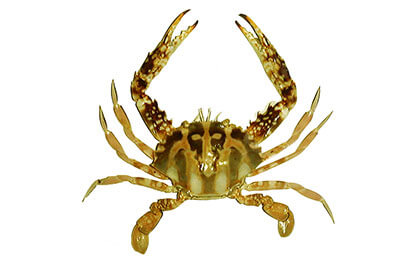Blue swimming Crab
Portunus pelagicus Males are bright blue in colour with white spots and with... Read More
Portunus pelagicus Males are bright blue in colour with white spots and with characteristically long Chelipeds, while female have a duller green/brown, with a more rounded carapace (shell). The carapace can be up to 20centimetres wide. It is a sea crab, they cannot survive for long periods out of the water, they come out to feed during high tide on various other mollucs and fishes. It is a delicacy in most part of the world. It has sweet nutty flavor, firm flesh. It has firm texture and delicate flavor. It is good for steaming, poaching, and pan frying.. Good for Indian curry, fry, crabs balls, soup. Meat portion is about 30 per cent of the crab.
View Less
Mud Crab
Scylla serata Also called mangrove crab, shell colour varies from deep, dottled... Read More
Scylla serata Also called mangrove crab, shell colour varies from deep, dottled green to very dark brown. This species preferred in aquaculture due to the high price, rapid growth rate and high tolerance. Mud crab are found in open, large esuaries with a muddy substrate. They live in burrows. They feed on tiny snail and dead fish. Colour uniformly dark greenish grey. Good for steaming, poaching, and pan frying. It has firm meat, medium sweet flavor.
View Less
Three spot Crab
Portunus sanguinokentus Carapace very broad with 3 red spots in posterior half... Read More
Portunus sanguinokentus Carapace very broad with 3 red spots in posterior half, at the rear of the shell; there is a strong spine on each side; claws are long and the rear swimming legs are flattened. This commonly trawled; it has short life span of around 2.5 years. It feeds on small crustaceans, molluscs and detritus. It inhabit sandy and muddy substrates in shallow water 10-30m. Meat of crab has rich sweet succulent and buttery nutty flavour. Body meat is white, tender and flaky, claw meat has a brownish tint
View Less
Coral Crab
Charybdis cruciata Cross like mark found on the carapace (shell) Shell hexagonal, moderately... Read More
Charybdis cruciata Cross like mark found on the carapace (shell) Shell hexagonal, moderately broad. Found in waters from 5 to 15 meteres depth, over sandy or muddy bottoms. Carapace broad and flat; 5 to 9 teeth on anterolateral margin, no spine on dactyls. Distal 2 segments of last pair of legs more flattened than in anterior legs, dactyl of last pair Of legs usually oval Body purplish brown with a large yellow cross; chelipeds purple, spotted with yellow dots
View Less
Crab from this family can usually be recognised by their flat, disc-shaped hind legs, used as paddle for swimming. They also have 9 spikes, called horns along either side of the carapace.
Crab are decapod crustacean having 5 pairs of legs
They live in all the world ocean in fresh water and on land , generally covered with a thick exoskeleton (shell)
Crab typically walk sideways, some can walk forward or backwards.
Crab are omnivores, feed on algae, other molluscs, worm and crustaceans.
All Crab species are low in fat and a good source of protein. Like other marine species, crab are rich in minerals like selenium and other nutrients. (seafoodhealthfacts.org)
Gujarathi – Karachala
Marathi – Khadapichimbori
Konkani – Kurilo
Kannada – Kallu Denji
Malayalam - Njandu
Tamil – Nandu
Telugu – Peeta
Oriya – Knakda / Manda peta
Bengali – Kankara
Precooking Crab
Prepare the water by placing in a handful of salt and bring it to the boil,
Add crab into the boiling water allow the water return to boil.
Remove the crab and rince in cold water.
Use half boilled or half steamed crab for grilling or curry of your choice



